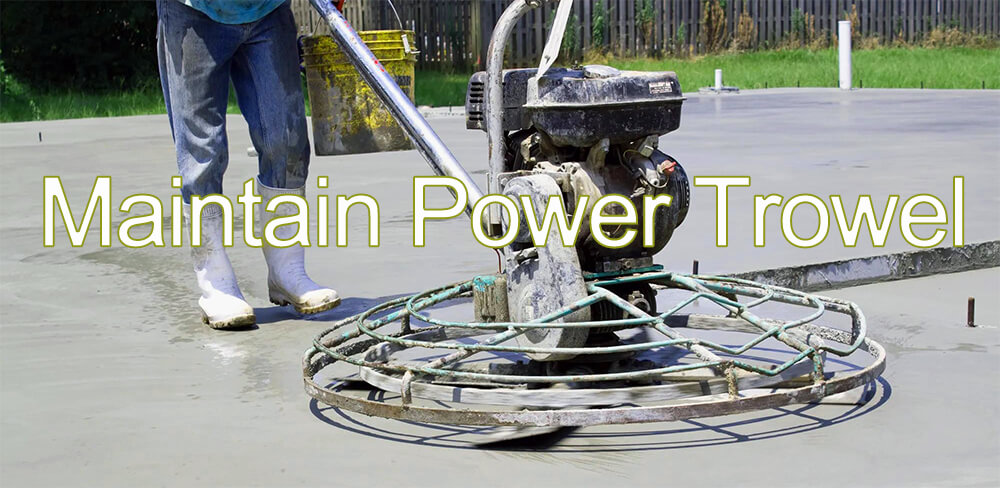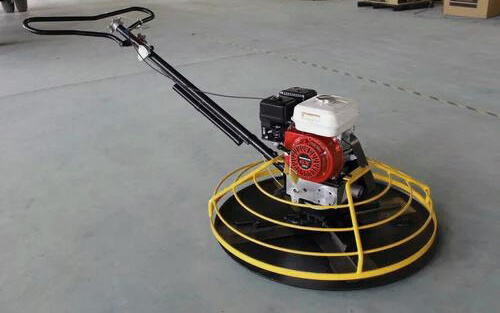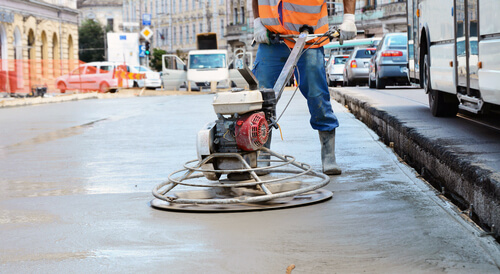03Jun 2023
table of contents
When creating a flat and dense concrete floor, the best tool for a contractor is the power trowel. Power trowels make floors smooth and thick by embedding aggregate and reinforcing mortar on the surface.
Power trowel maintenance is simple, and a properly cared-for machine will continually assist contractors in obtaining desired outcomes.

Here are some simple and easy steps suggested by BISON to help you maintain your power trowel.
Maintenance of key components: power trowel blades. The critical components of the walk behind trowel are the blades and float pans, which come into direct contact with the concrete. The blade is the first component a contractor should check before operating a power trowel. Ensure the blade arm is straight and not curved, which can cause uneven blade wear. Operators should also make sure the blade is tilting at the same rate.
After checking the blades, verify that the emergency stop function is working properly. To do this, place the emergency stop switch in the "on" position, start the engine usually, then flip the switch to "off." The engine should stop immediately. The switch should also move quickly between the "on" and "off" positions, without obstructions or friction.
Some contractors skip the inspection because they disabled emergency stop switches, but it's dangerous. BISON recommends keeping all contractors required to ensure this safety component is functioning properly, otherwise during operation, the operators are easy to loses control, the entire power floor trowel could start spinning at high speeds, potentially causing injury.
Oil should be checked daily and changed after every 50 hours of use. The oil in the gearbox should be changed at least once a year.
The air filter must also be checked or replaced before using the power trowel. Site conditions will determine the life of the air filter. Using a hand trowel on a dusty or dirty job site will shorten filter life.
Before using a hand trowel, check the tension of all belts. Belts stretch due to tension and need to be tightened periodically. If the machine has multiple belts, they should be replaced simultaneously. You want to start with belts that are the same size and have them stretch together. We also recommend tightening the straps after the first use to compensate for the initial stretch.
The contractor shall periodically check the engine to ensure it runs at the manufacturer's recommended speed. Most lawn and garden stores sell cheap tachometers that show engine speed. Point the tachometer at the spark plug and read the tach display. Always ensure the engine is set to the manufacturer's recommendation and adjust the revs according to the manufacturer's procedure.

A clean power trowel lasts longer. Clean the machine thoroughly after every use to remove abrasive concrete from the power trowel. BISON recommends using a pressure washer, but keep in mind that it may be necessary to remove concrete from the power trowel at times. When required, we recommend that contractors use an ice scraper or stake to minimize damage to the paint while scraping. We also recommend applying some mold-release agent to the power trowel or using one of the available concrete cleaning products. Some reagents are biodegradable products that can be sprayed on the power trowel to keep it clean.
As the blade wears down, it's easy for contractors to notice the certain blade areas are thin and flake off. It looks like aluminum foil or wire. Upon noticing this, the contractor should replace the blade.
And comprehending that when one blade gets worn out, all blades must be changed concurrently to preserve uniform work is crucial. Failing to do so might significantly impact the floor's flatness and overall quality.
The blade arm should be lubricated every 50 hours to prevent premature wear on the lower end. This is important because concrete is very abrasive, and adequately lubricating the blades can save on replacement costs. See BISON or your operator's manual for the grease fittings' location and the type of lubricant to use.
Besides, use only approved concrete trowel blades of the correct type and size to avoid hazards. All blades should be kept in their protective cages.
The throttle cable, pitch mechanism and engine starter rope should also be kept clean. The throttle cable and pitch mechanism should be well-lubricated to move freely. The engine starter rope wears out at an accelerated rate because the power trowel is used in an abrasive environment.
Many contractors angle the power trowel perpendicular to the ground to clean the bottom. Contractors should avoid the practice because they risk leaking oil and fuel from the machines. Adjusting the power trowel this way can also cause oil to reach the top of the piston cylinder, which can cause the engine to seize.
To be safe, contractors should keep labels on machines clean and legible. Tags aid in proper operation and should be seen by anyone using the device.

For those of you who own a power trowel, consult the manufacturer's maintenance manual to ensure your equipment is operating efficiently. Here are some simple tips on how often you need to perform maintenance when using your trowel.
Daily maintenance
Without a doubt, the most important daily task to keep your power trowel looking and working like new is power washing it. Grease and debris can wreak havoc on many parts of your power trowel, so using a power washer at the end of the day will help keep everything clean and ready for tomorrow.
You'll also want to double-check engine components daily. This is usually best done before starting work. Specifically, you'll need to look at the air filter, as concrete dust can quickly build up and kill your engine's power.
As with any equipment, checking fluid levels, including oil and liquid coolant, is a good idea.
Finally, before using your power trowel for the first time each day, perform a brief visual inspection to verify that all components are properly connected and safety guards are properly in place.
Weekly maintenance
Every week, you need to check the bottom of your power trowel. In particular, you'll want to check the blade and the spider arm holding it. Any of these damages can cause irregularities or patterns in the concrete surface.
Drive belts also require periodic inspection. If left unchecked, the heat can damage the rubber band, resulting in hours of loss. A weekly inspection will allow you to replace the belt when it shows signs of wear.
Monthly maintenance
Your daily routine checks of fluid levels and engine parts can lead to identifying essential monthly maintenance tasks. Additional work may be required regularly, and while it's unlikely that oil and coolant changes will be required every month, you can safely set aside some time each month for work beyond your daily and weekly checks.
Annual maintenance
Power trowels typically last between 300 and 500 hours a year. You may exceed that amount in a few months or years, depending on your needs.
Even if you need to meet the usage required by the manufacturer's annual engine maintenance plan, some yearly tasks are best practices.
For example, gearbox oil should be changed approximately every 12 months. This dramatically extends the life of your power trowel and is a good idea even if you use it less than you would typically use it in a year.
The annual inspection is also an excellent time to adjust the blade and arm and the blade tilt mechanism. Throttle cable maintenance is also crucial for power trowels.
When a power trowel needs to be left for a while, its blade should lie flat, not angled.
If the power trowel is stored for an extended period, drain the fuel or add a stabilizer to the tank and carburetor. Store the machine in a protected area where it won't be exposed in its natural setting, and cover it.
Safety holds the top priority for all, ranging from novices to experts. It is advisable to thoroughly go through the instruction manual before operating the power trowel for the first time. As machines may vary, this guarantees the safe usage of the equipment and helps achieve improved outcomes. In case you haven't operated this kind of equipment earlier, seek guidance from an individual experienced in power trowels prior to attempting it on your own.
Of course, wear proper footwear, clothing, and personal protective equipment when using a power trowel. Construction boots, a helmet, and eye and ear protection should always be worn, and clothing should be tight enough. In case you suffer from neck or back issues, seek advice from your physician and exercise caution while operating the walk-behind power trowels.
Always inspect your power trowels for worn and damaged parts before each use.
Most walk-behind and ride-on power trowels are compact and easy to transport. It is essential to transport power trowels from storage to the job site carefully. Damage to power trowels often occurs during transport between locations due to insufficient safety measures. Make sure that the equipment is firmly fixed during transportation. After arriving at the job site, be sure to check the power trowel before using it.
It is recommended to clean the power trowel after each use to prevent the build-up of concrete residue. Regular cleaning helps maintain the performance and life of your machine. Use a pressure washer or hose to remove concrete debris and grime from the power trowel surface and blades.
Regular blade inspection is essential to maintaining your power trowel. Ideally, it would help if you inspected your blades before each use. Look for signs of wear, cracks, or any damage that may affect its performance. Replace worn or damaged blades immediately to ensure optimal results and minimize the risk of accidents.
Power trowels are simple to operate and effortless to maintain. By replacing all blades and filters when needed, keeping the machine in a clean condition and following the maintenance procedures above, the power trowel will continue to help keep concrete floors flat and compact over time.
inquiry form here
BISON BLOG, All the latest news and views from Bison Machinery.